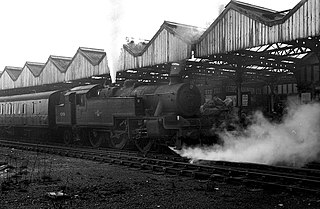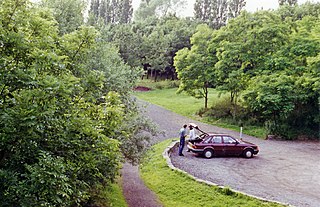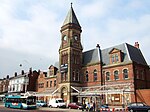The Liverpool, St Helens and South Lancashire Railway, was formed in 1889, but no services ran until 1895 and then only freight. Passenger services did not start until 1900. It incorporated the St Helens and Wigan Junction Railway. It was taken over by the Great Central Railway in 1906.

Wigan Central railway station was a railway station near the centre of Wigan, Lancashire, England.

Hindley South railway station served the communities of Hindley and Platt Bridge, south-east of Wigan, England.
Appleton railway station served a primarily industrial area of Widnes, England. It was located on the southern section of the former St Helens and Runcorn Gap Railway.
Ashton-in-Makerfield railway station was a railway station serving the town of Ashton-in-Makerfield, although it was located in the neighbouring village of Haydock, formerly in Lancashire, England.

Culcheth railway station served the village of Culcheth, Warrington, then in Lancashire, later in Cheshire, England. It was situated immediately west of the bridge whereby Wigshaw Lane crossed the railway.

Whelley railway station was in Whelley, Wigan on the Whelley Loop section of the Lancashire Union Railway. The station was situated where the B5238 bridged the line.

St Helens Central (GCR) railway station served the town of St Helens, England with passenger traffic between 1900 and 1952 and goods traffic until 1965. It was the terminus of a branch line from Lowton St Mary's.
Tanhouse Lane railway station is a closed station on the former Sheffield and Midland Railway Companies' Committee line, which formed a loop off the Cheshire Lines Committee (CLC) line in the Widnes area between Liverpool Central and Manchester Central. It was opened on 1 September 1890 as "Tanhouse", being changed later to "Tanhouse Lane". It closed on 5 October 1964.
Farnworth & Bold railway station served the Farnworth area of Widnes, England. The station was on the southern section of the St Helens and Runcorn Gap Railway which was later absorbed by the London and North Western Railway.
Peasley Cross railway station served the central southern area of St Helens, England. It was situated on the central section of the St Helens and Runcorn Gap Railway which was later absorbed by the London and North Western Railway.
Fidler's Ferry & Penketh railway station was on what is now the southwestern edge of Warrington, England. It was located at a point where the St Helens and Runcorn Gap Railway, the Sankey Canal and the River Mersey come side by side and where a ferry at one time plied across the river. In modern times the station site is at the southern, canal end of Station Road, Penketh.
Haydock Park railway station was a railway station adjacent to Haydock Park Racecourse, formerly in Lancashire and now in Merseyside, England. The station's sole purpose was to handle race day traffic. It did not feature in public timetables and normal service trains passed through the station without stopping.

Golborne North railway station served the town of Golborne, in the Metropolitan Borough of Wigan, Greater Manchester, England.
Lowton St Mary's railway station served the scattered community of Lowton, then in Lancashire, now in Greater Manchester, England. It was situated immediately south of the A572 bridge over the tracks.

Lower Ince railway station was a railway station in southern Wigan, Lancashire, England.

Bickershaw and Abram railway station served the communities of Bickershaw and Abram southeast of Wigan, England.

The West Leigh and Bedford railway station served the hamlet of Crankwood, the village of Abram, and the Plank Lane area of Leigh, England. Like many railways, the line passed between rather than through communities, with branches off to serve the key driver - goods, and in this area - coal.

Lowton railway station served the village named Town of Lowton to the east of Newton-le-Willows and south of Golborne.

Bamfurlong railway station served the village of Bamfurlong part of Abram, to the south of Wigan.












